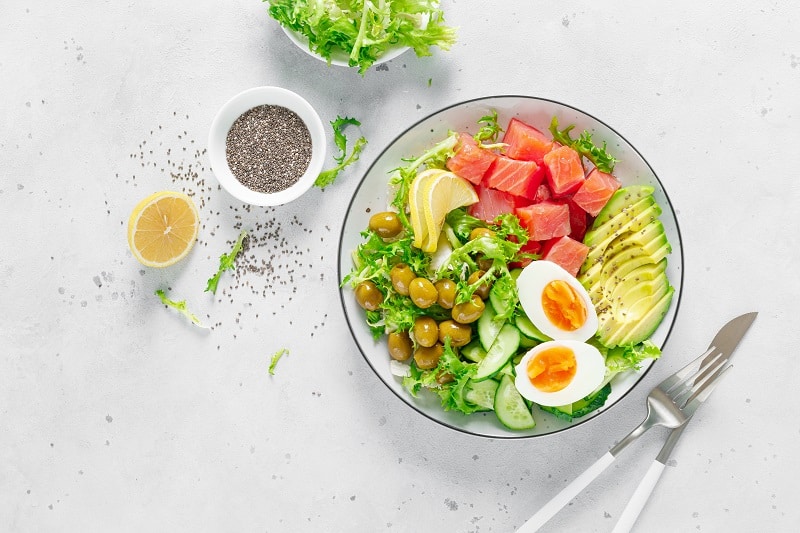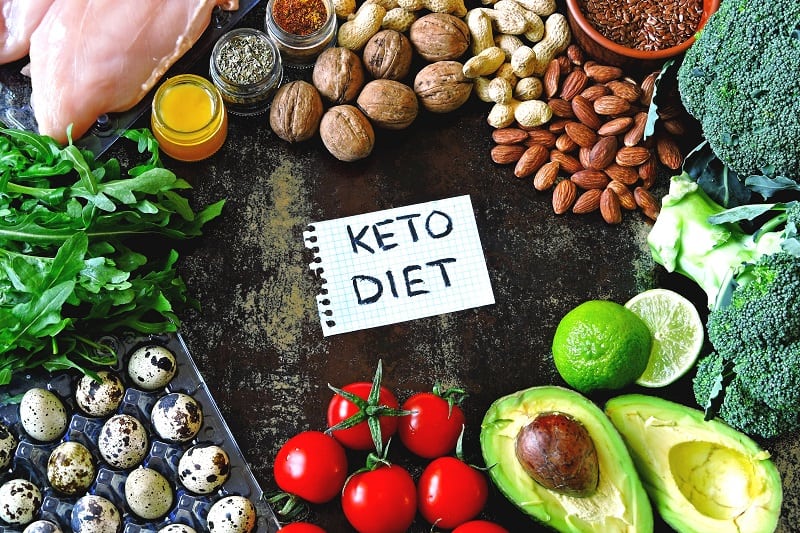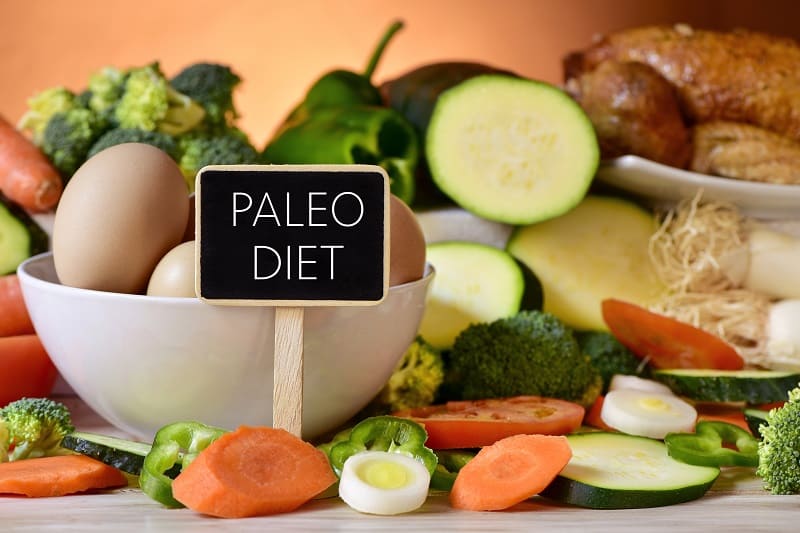
Is Keto or Paleo Right for You?
How many diets have you heard of in your lifetime? Likely quite a few. Just like other fads, diets have come and gone in popularity over the past few decades. Diets can seem attractive for those who want something concrete to follow and tend to attract people who have had a difficult time meeting their nutrition and health goals on their own.
The downside is that diets often don’t work long-term, especially for weight loss. Studies have found that 80% of people who lost a significant amount of weight (at least 10% of their starting body weight) regain the weight after a year.
Some people find diets to be sustainable, especially if they don’t start the diet with the sole intention of losing weight. Maybe you want to try changing your eating habits to help manage your blood pressure or autoimmune disorder, or another health reason. Some of the more popular diets people have been talking about are the ketogenic (keto) diet and the paleolithic (paleo) diet.
What Is the Keto Diet?

The ketogenic diet, most often referred to as just “keto,” has actually been around for much longer than it’s been popular. The ketogenic diet was used in the early 1900s as a treatment for epilepsy, a type of seizure disorder. It regained popularity in recent years, especially for people wanting to lose weight.
The ketogenic diet is very low in carbohydrates, a type of nutrient found in foods like fruits, vegetables, legumes, grains, and some dairy products. While actual amounts of macronutrients may vary, a keto diet usually doesn’t contain more than 50 grams of carbohydrates per day, with many people preferring to keep their carb intake to fewer than 25 grams per day. For reference, the current dietary guidelines recommend consuming around over 200 grams of carbohydrates for a standard 2,000 calorie diet.
With a very low-carbohydrate diet like the keto diet, fat and protein make up the majority of the macronutrients. Keto diets usually consist of around 70-80%fat, much higher than the dietary guidelines of 20-35% of total calories from fat.
When carbohydrate intake is low and fat intake is high, it promotes a metabolic state of ketosis. In ketosis, the body burns fatty acids for fuel instead of carbohydrates. Burning fat can mean more fat is burned for energy, which can result in weight loss. Having a low intake of carbohydrates can also reduce insulin levels, which can also promote weight loss and improve blood sugar levels.
Pros of the Keto Diet
Lower insulin levels: Carbohydrates break down into sugar when they’re digested. When you eat carbs, a hormone called insulin is released to help keep blood sugar levels at a healthy balance. Insulin is a fat-storage hormone, which means it can promote storing of energy versus burning energy.
With the keto diet, insulin levels are usually reduced due to the very low levels of carbohydrates. Reduced insulin levels can be a good thing, especially for those with insulin resistance. Insulin resistance is a condition where the body doesn’t respond to insulin effectively and is the leading cause of type 2 diabetes. It is also associated with Polycystic Ovarian Syndrome, a leading cause of infertility in women.
A meta-analysis of 13 studies concluded that a ketogenic diet can improve blood sugar levels in people with existing type 2 diabetes, and it may even promote healthier blood fat levels as well. However, there are limited studies on the long-term efficacy of the keto diet, so more research needs to be done in this area.
Low in added sugars: Added sugars are those that don’t occur naturally in the food and are added solely for the purpose of flavor. Many foods and drinks contain added sugar, such as soda, flavored coffee, cereal, granola bars, and even many kinds of dried fruit.
The American Heart Association recommends limiting added sugars to fewer than 25 grams per day for women and fewer than 36 grams per day for men. The average American consumes 88 grams of added sugar per day, which far exceeds the recommendation.
Because it’s low in carbohydrates, the keto diet is very low in added sugars. Cutting back on added sugars has several perks, such as promoting weight loss, reducing insulin resistance, and even potentially reducing your risk of heart disease.
Possibility of disease reduction: A study concluded that being in ketosis can have several health benefits, such as improvement in neurodegenerative diseases (like Alzheimer’s) and cancer. However, more good quality, long-term research needs to be done before this possible correlation can be solidified.
The bottom line: The keto diet has shown some promise for its potential health benefits, but we need more information before we can confidently recommend it based on scientific research.
Cons of the Keto Diet
Very restrictive: Because the keto diet is so low in carbohydrates, that means many foods aren’t “allowed” or should be eaten in very low quantities. Foods like bread and other grains, fruits, legumes like beans, milk, and certain vegetables are all sources of carbohydrates, which are extremely limited on a keto diet.
When diets are restrictive, there is a higher likelihood that the people following them won’t be able to stick with it on a long-term basis. If there are health benefits from following keto, then you won’t be benefitting from them long-term if you can’t stick with the diet.
Can raise cholesterol levels: Very high fat intake, especially saturated fat from foods like meat and full-fat dairy, can raise LDL cholesterol levels. LDL is considered “bad” cholesterol because it’s associated with an increase in plaque buildup in the arteries, which can reduce blood flow. Having high LDL cholesterol is one of many risk factors for heart disease. Studies have found that a keto diet can raise LDL cholesterol levels, so people with a history of heart disease may want to consult with their healthcare provider before jumping on board with a keto diet.
Low in fruits and other sources of fiber: Because it avoids whole grains, legumes, and most types of fruit (or at least significantly restricts fruit intake), the keto diet has the potential to be lower in natural fiber. Fiber-rich diets are beneficial for good digestive health and also play a role in blood sugar regulation and heart health. A very high-fat and high-protein diet can be low in fiber, which is one of the potential drawbacks.
See more about - Everything You Need To Know About The Ketogenic Diet
What Is the Paleo Diet?

The paleolithic diet, otherwise known as “paleo” or “the caveman diet,” is less restrictive than a ketogenic diet. The goal of the Paleo diet is to eat foods that our caveman ancestors ate thousands of years ago through hunting and gathering. The paleo diet includes foods like meat, fish, fruits, vegetables, nuts, and seeds. It avoids foods that became popular once farming began, such as dairy, legumes, grains, and refined sugars.
Pros of the Paleo Diet
Low in refined sugars: Similar to the keto diet, the paleo diet is usually low in refined sugars, since those weren’t around until long past the caveman era. The majority of sugar-sweetened foods are sweetened with refined sugars like cane sugar and corn syrup, which means that your added sugar intake would likely see a dip if you adopted a paleo diet. That’s not to say the paleo diet is automatically low in sugar, since natural sweeteners like honey are still allowed.
Avoids refined carbohydrates: Many of the grains consumed by Americans are refined grains, such as white bread, white pasta, and others. Refined grains are lower in fiber and other nutrients, and can even raise triglyceride (blood fat) levels and raise cholesterol when they’re eaten in place of saturated fat. Because the paleo diet is free of these grains, there is more room for more nutrient-dense foods like sweet potatoes, nuts, seeds, and vegetables that can be used in place of grains (here’s looking at you, cauliflower rice!).
Less restrictive than keto: The paleo diet doesn’t have set macronutrient limits and there is a broader variety of foods that are paleo-friendly, which means this diet may be more sustainable compared to keto.
May help symptoms of autoimmune disorders: Some people find some relief from symptoms of their autoimmune disorders while following a paleo diet, such as those suffering from Crohn’s disease. The “Autoimmune Protocol”, an extension of the paleo diet, has been scientifically proven to reduce symptoms in inflammatory bowel diseases like ulcerative colitis and Crohn’s disease.
Cons of the Paleo Diet
Potentially low in calcium and vitamin D: Dairy products are one of the biggest contributors of calcium and vitamin D in a typical Western diet. The paleo diet avoids dairy, meaning you’ll have to find these nutrients in other foods. While not impossible by any means, dairy products are a convenient way to meet calcium and vitamin D needs, so without carefully planning a paleo diet, there could be a chance for nutrient deficiencies.
Not ideal for vegans or some types of vegetarians: Vegans and vegetarians typically rely on legumes and soy for protein, which aren’t typically considered paleo-friendly. Without being able to rely on legumes and soy, that would leave very few choices to meet protein and iron needs on a vegan paleo diet.
It can get pricey: Eating a diet consisting of more meats, fish, nuts, and seeds can get expensive, especially if you’re used to utilizing more budget-friendly proteins like peanut butter, beans, and dairy products.
Bottom Line: Are Keto or Paleo Right for You?

There are many things to consider before deciding to try a keto or paleo diet. There are potential benefits for both diets, but they both come with their own drawbacks. Of the two diets, the paleo diet is more well-rounded and less restrictive. While the keto diet has been shown to have specific health benefits, all of the research done on it to date emphasizes the need for more long-term studies.
If you have a history of trying different diets and having your weight yo-yo, then trying yet another one might not give you the results you want. Think about your main reasons for wanting to try a diet in the first place. If you want to cut back on sweets or carbs, then you can always adopt aspects of keto or paleo without committing to following a strict diet.
The bottom line: making changes to your eating habits isn’t a short-term fix; it’s a marathon, not a sprint. Choose an eating style that you think will be realistic and sustainable. The diet should also align with your current state of health and consider any other medical conditions you have. Be sure to also consult with your local health professional to make sure you choose the right diet that will suit your needs.
